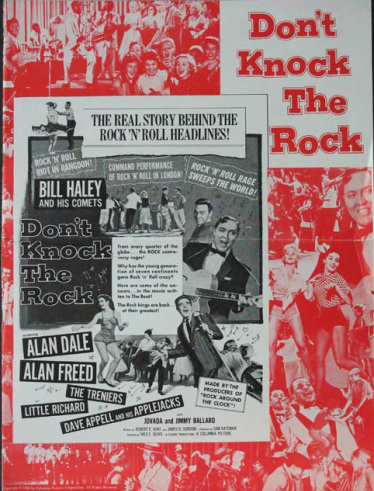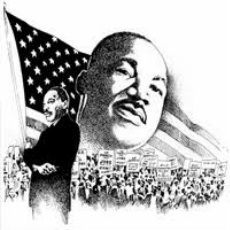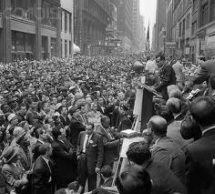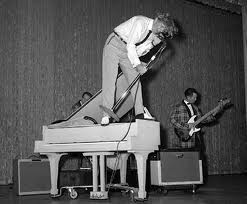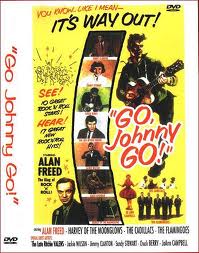Don't Knock the Rock : rock 'n' roll movies as markers in 1950s U.S. civil rights movement
Don't Knock the Rock, the quick follow-up to Rock Around the Clock is a neglected but interesting movie in its own right
The tremendous box office success of Rock Around the Clock meant that within months a follow-up was rushed into cinemas. With the same studio, producer and director, and retaining the presence of Bill Haley and the Comets, Don't Knock the Rock, although commercially successfully, never attracted the massive publicity and media attention of its precursor. Other studios quickly churned out rock 'n' roll movies, (including the much superior The Girl Can't Help It with its anarchic and sexualised satirical take on rock and roll and outstanding performances) soon diverted attention from Don't Knock the Rock. Yet this overlooked movie is significant for several reasons.
Not only did it reveal producer Sam Katzman's ability to recognize trends in American popular culture (especially youth culture) and exploit them by rushing out cheap, quick movies that referenced these trends. Don't Knock the Rock was essentially Rock Around the Clock revisited, although with stronger dance sequences and an even more assertive message that rock 'n' roll was not only part of the proud American tradition of dance music and not, as its enemies proclaimed, a dangerous music destructive of family values and the source of inter-generational conflict.
Don't Knock the Rock also went to some trouble to defend teenagers. The movie's juveniles are not switchblade-wielding hoodlums out looking for trouble. Nor are they mumbling, surly, ungrateful offspring in conflict with their parents. Instead, they are depicted as wholesome, polite,clean-cut, well-dressed individuals anxious to keep their parents' respect. They seek to ensure parental support for rock 'n' roll by showing it as an exuberant dance-form just like jitterbugging was to their mothers and fathers. In fact, one of the movie's weaknesses is its casting of Alan Dale, (a once-popular singer in the late 1940s and early 1950s who had his own TV show for a time) in a lead role, presumably to appeal to parents. The movie also unrealistically goes out of its way to ignore the sexual and rebellious elements that was part of rock 'n' roll's appeal.
|
|
|
|
In 1967 M.L.King Jr praised disk jockeys who had spread the gospel of R & B and rock 'n' roll. Such music, he said, created "a powerful cultural bridge between black and white". Integration of black and white youth was made easier because they now had "a common music, a common language, and enjoy the same dances". That music and its dance forms "now sweep across race, class and nation".
Some black rock 'n' rollers used their songs to send coded messages. Chuck Berry's famous "School Days" includes the lines: "Hail Hail, rock 'n' roll Deliver me from the days of old The feeling is there, body and soul". |
Rock 'n' roll and rhythm and blues music of the 1940s and 1950s is now finally recognized by some historians as a leading factor in the slow and painful erosion of segregation in postwar America. It was a catalyst in easing the process from segregation to desegregation and eventually, integration. That music, and its various offshoots, became a source of pride for African-Amercians, and for some of them, a means of income and public status. It even made show business celebrities out of a few. Equally importantly, rock and roll became a source of cultural contact between whites and blacks. Its popularity transcended racial and class divisions.
The emergence of rock 'n' roll to the attention of the mainstream American public, via movies, starting in 1955 with Blackboard Jungle and Rock Around the Clock in 1956, occurred at the same time that civil rights became a fundamental Issue in the USA. The Supreme Court had declared segregation in public schools to be unconstitutional in 1954 and during the next three years several events kept the issue in the public eye. These included increased assertiveness amongst many African-Americans in emphasizing their black cultural identity, and the events at Little Rock High School in 1957.
The emergence of rock 'n' roll to the attention of the mainstream American public, via movies, starting in 1955 with Blackboard Jungle and Rock Around the Clock in 1956, occurred at the same time that civil rights became a fundamental Issue in the USA. The Supreme Court had declared segregation in public schools to be unconstitutional in 1954 and during the next three years several events kept the issue in the public eye. These included increased assertiveness amongst many African-Americans in emphasizing their black cultural identity, and the events at Little Rock High School in 1957.
Alan Freed - promoter of rock 'n' roll and black performers
|
|
Alan Freed appeared in both Rock Around the Clock and Don't Knock the Rock as well as three other rock 'n' roll movies - Rock, Rock, Rock!, Go, Johnny, Go and The Alan Freed Story. During the early 1950s Freed was a crucial figure in introducing white America to musical forms usually associated with African-Americans and working-class whites.
Born in 1921, Freed's adolescence in Ohio included forming his own band, the Sultans of Swing, and listening to big band music. By age 21 he was working in radio and in 1945 he became a DJ in Akron. Six years later when he moved tro Cleveland, he hosted the 'Moondog Show' which specialised in 'race music' : mainly rhythm 'n' blues, which supposedly appealed only to African-Americans. But Freed not only liked such music himself; he realised that many white listeners, especially the young, were also enthusiasts. He began calling R & B music 'rock and roll' in an effort to disguise the racial origins of the music and probably well aware that the term was an African-American euphemism for sex. Freed's 'Moondog' show was an enormous success with black and white alike. When he held a Moondog 'Rock'n' Roll Ball' in Cleveland in 1952 tw-thirds of the huge audience were white. In 1954 he moved his Moondog radio show to New York's famous WINS station and started a series of rock 'n' roll concerts. He also starred in several early rock 'n' roll movies, including Rock Around the Clock, Don't Knock the Rock and his own bio-pic, Mister Rock and Roll. They provided moviegoers worldwide with an introduction to the music and for the sharp-eyed. clues to guitar-playing techniques, as well as a chance to see on film previously obscure artists. Thus Freed was instrumental in spreading the appeal rock 'n' roll from a limited ethnic and regional base into a musical genre with international and multi-racial appeal. Although he lacked charisma on screen and had an old-fashioned paternalistic image, he was able to convey to listeners and movie audiences his intense enjoyment of the music and his passionate determination to spread its appeal. Unfortunately, Freed's downfall was imminent. He was already unpopular with some U.S. authorities and entrepreneurs for his support of black music and for helping move that music's popularity across ethic lines. In 1957 NBC cancelled his televised musical show when Frankie Lymon was showing dancing with a white girl. In the late fities and early sixties he was accused and was made the convenient scapegoat for the musical industry's 'payola' scandal (disk-jockeys took money for promoting certain songs). Convicted and fined for commercial bribery, Freed turned to alcohol in his unsuccessful struggle to resuscitate his career. He dies aged 43 in 1965 an unemployed, sick bankrupt. |
|
The influence of Rock Around the Clock: satire, sex and rock 'n' roll in The Girl Can't Help It
|
So successful was Rock Around the Clock that Hollywood immediately produced several blatant rip-offs, including Sam Katzman's Don't Knock the Rock. The most significant of these was The Girl Can't Help It. Although this movie, like the others, aimed at exploiting the rock 'n' roll phenomenon, Girl had important differences. It was made in color and widescreen. It used several B-list stars and the physical attributes of Jayne Mansfield, a Marilyn Monroe clone. And the movie was directed by Frank Tashlin, admired in both Hollywood and France for his offbeat and innovative approach to film comedy.Tashlin had no intention of making a tribute to rock 'n' roll. Instead, he satirized the music and the show biz hype surrounding its performers, audiences and those looking to make money out of the phenomenon.
The Girl Can't Help It was also intended to attract not just teenagers; it assumed that older audiences would be receptive to the movie's music as well as to its satirical attitude towards on the musical industry.In this movie, rock 'n' roll was accepted as a new genre within American cinema musicals. It took its place alongside another genres featured in the movie: rhythm and blues, swing, torch, jazz blues. Tashlin also incorporated the sexual suggestiveness of rock 'n' roll to augment the movie's considerable verbal and visual innuendo . Rock Around the Clock and Don't Knock the Rock quickly established rock 'n' rolls appeal to an audience much wider than that of teenagers. The Girl Can't Help It continued this porocess in a much more sophisticated process, both cinematically and musically. |
|
